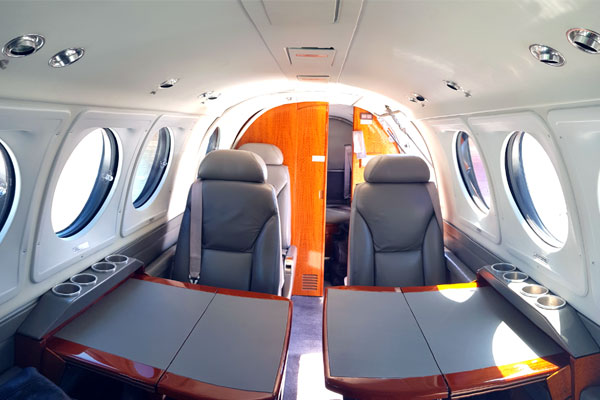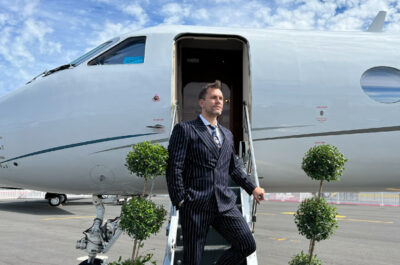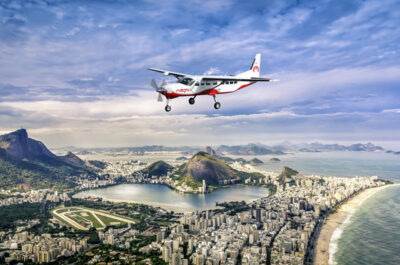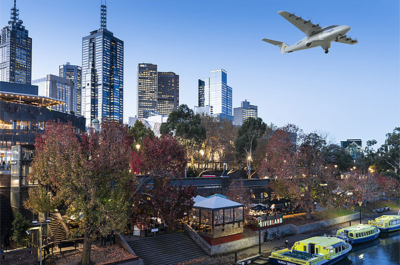
King Air B200 GT, with a specially adapted 7th seat is used by Flapper for its scheduled operations between Sao Paulo and Rio de Janeiro.
You already know that flying private saves time and allows for hassle-free travel to your favorite destinations. Unmatched and unparalleled, private jet transportation is the favorite of business and leisure travelers alike. Just drive up to your airplane, swiftly walk up the ramp, and enjoy aviation as it was meant to be. No wasting time at main airports, no security lines, and no mediocre customer service. Sounds expensive, doesn’t it? While some of the best things in life are free, flying
You already know that flying private saves time and allows for hassle-free travel to your favorite destinations. Unmatched and unparalleled, private jet transportation is the favorite of business and leisure travelers alike. Just drive up to your airplane, swiftly walk up the ramp, and enjoy aviation as it was meant to be. No wasting time at main airports, no security lines, and no mediocre customer service. Sounds expensive, doesn’t it?
While some of the best things in life are free, flying private is definitely not one of them. Traditionally, having a private aircraft in the sky just for you came attached with a heavy price tag. It wasn’t until the 1980s that the new commercial models really took off in the US, effectively cutting the costs of owning a private jet by some 60-80%. The subsequent arrival of memberships, private airlines, and digital brokers further democratized the market and brought it closer to upper-middle class audiences.
Have you ever wondered what the best way to fly private is? If you are looking for a concrete answer, I regret to inform you it’s not here. In an industry known for its bespoke itineraries tailored to the needs of high-net-worth individuals, a combination of two or more aviation products usually constitutes the best option. The correct question might: “which service best suits my needs at the given moment?”
My name is Paul Malicki, and I am the CEO of Flapper, a leading on-demand aviation platform in South America. Today, I will present to you some of the most popular ways of procuring private jet travel.
For control freaks – buying your own airplane
With prices of personal jets starting at $2 million (Cirrus Vision Jet) and an over-supply of used aircraft on the market, there has never been a better time to buy your own airplane. Reserved for the wealthiest clientele, the private ownership model is especially popular among business people flying 300 or more hours per year.
But be careful. Buying your own aircraft is associated with a number of hidden costs and extra responsibilities. It needs to be crewed, certified, maintained, and updated constantly. Think of it as of buying a very expensive car, which can only be repaired at certified workshops and driven (piloted) by the best drivers (pilots), who eventually might become your employees.
Some of the benefits of owning a new aircraft include the possibility of customizing the interior and the exterior of the jet. Users with preferences for certain equipment, seat configuration, or even avionics are in full control of the end product.
Private jet ownership means you control the costs and enjoy undisrupted access to the aircraft. Business people who don’t particularly enjoy paying standby fees, or suffer from last-minute itinerary changes, will greatly enjoy the ownership model. You can select your own FBO and change the itinerary without compromising the aircraft schedule.
Those users who tend to mix international itineraries with domestic trips will quickly realize that owning just one aircraft might not be enough. The decision to buy a given model is a tough one and once you get what you want, you must “stick to it”. A popular King Air B200 won’t be able to operate transcontinental flights. Vice-versa, it probably makes little sense to engage a 15-person Gulfstream on a short, 1h-long mission. That’s why every now and then the most vivid business travelers charter a third-party jet (or choose a different aviation product which better suits their needs).
- Aircraft Ownership Pros: Symbol of status, high availability, customization
- Aircraft Ownership Cons: High costs, lack of flexibility for certain routes
- Aircraft Ownership – Best for: Frequent flyers (200h+ a year) with difficult schedules
- Aircraft Ownership – Where to buy: directly with OEM (Embraer, Bombardier, Pilatus) or a specialized airplane selling / leasing company.
Ownership 2.0, i.e. Fractional Shares
Do you want to own an aircraft without looking after maintenance costs, pilot salaries, or insurance? Fractional ownership providers sell one aircraft to multiple owners, hence decreasing the fixed costs and gaining a better economy of scale.
Aside from a visible cost reduction, fractional ownership brings professionalism and consistency to the private aviation experience. Passengers usually benefit from flying on the same aircraft (model), with standardized interior equipment and exterior patterns. More established players might offer access to a shared fleet, where users can fly on each other’s aircraft without owning a share of every single aircraft. Such businesses operate under a special subsection of the regulatory framework, which in the US is called Part 91K, which allows them to “charter” the aircraft to a closed group of members. In Brazil it is yet to be made 100% legal.
The fractional quota can correspond to just 1/15 or even 1/4 of the nominal aircraft price. The management (maintenance) fees are considerable and vary from US$ 7,000 a month in Brazil to around US$ 10,000 a month in the US. Depending on users’ individual- or corporate tax structure, members can also qualify for tax deductions.
One of the key disadvantages is the long-term character of the fractional ownership program. Owners often find restrictions “dropping out” of fractional membership and might even be required to find a new member to buy their quota on leaving. It’s worth highlighting that smaller fractional providers offer little-to-no flexibility. The clients buy into a limited-size fleet, what drastically reduces the number of available options, forcing the users to charter the aircraft whenever necessary.
- Fractional Ownership Pros: Consistent experience, increased safety, reduced costs
- Fractional Ownership Cons: Recurring expenses, fleet size depends on the provider
- Fractional Ownership – Best for: Wealthy frequent flyers (50-200h+ a year)
- Fractional Ownership – Where to buy: Flexjet, NetJets, AirSprint (US), Avantto (Brazil), JetFly (EU)
No strings attached – On-demand charter
In my personal opinion, the charter model defines what private aviation is all about. High-quality personalized service and immediate access to the most diversified fleet are some of the benefits of chartering a jet from a specialized company or an operator.
Charter clients select a preferred type of aircraft and rent it for a given day and route. The charter price is estimated beforehand, based on hourly costs and might be guaranteed or subject to minor alterations. The latter happens when the operator pre-charges the client’s credit card and reserves the right to impose the final charge once the total time of the flight has been accrued. Such a practice, although not particularly favored by the end clients, is used in order to compensate for potential changes to the itinerary (in practice, the flight never takes exactly as long as estimated).
Contrary to the US, Brazilian charter flights are typically charged on a per-km basis. Except for helicopter rentals, where hourly rates are applied, operators typically guarantee a quoted price, based on the distance and the FBO selected beforehand. As of today, out of the more than 90 active charter operators, just two of them calculate their jet- and turbo-prop flights on a per-hour basis.
Charter flights guarantee a high level of professionalism. Typically, an aircraft can be made available within 2 hours of a charter request. Charter operators or specialized charter service providers offer a consistent on-board experience and a standardized booking process, with automated quotations and flight monitoring systems. Since the customer has no obligation to return to the given service provider, companies make sure that they provide an excellent service and recall customer preferences for their next flight.
Thanks to the Part 135 certification (a regulatory frameworks used in the US – FAA, Brazil – ANAC, and Europe – EBAA), such flights impose an extra layer of safety as well. Part 135 is a set of rules that impose more stringent safety and maintenance standards for charter operations and all charter jet providers around the world must follow them.
Less frequent users benefit from transparent, one-off pricing. Since there are no membership fees, all one pays for is the flight itself. Cancellation policies vary from flexible cancelation models to full 100% charges on the cancelled flight on the day of the departure. That’s the only downside.
- On-demand Charter Pros: Wide array of options, increased safety, transparent pricing
- On-demand Charter Cons: Cancellation policies; costs grow proportionally with flying hours
- On-demand Charter – Best for: Jet setters looking for flexible options.
- On-demand Charter – Wehere to buy: Operators (Vista Jet, JetStory), Traditional brokers (Chapman, PriveJets), Digital marketplaces (Victor, Stratajet, Flapper)
Prepaid jet cards
A jet card is nothing else than a pre-paid system for the purchase of flight hours, usually on a specific aircraft (say, King Air B200) or aircraft category (turboprop, in this case). Jet card providers typically own their fleet and offer an agreed-upon fixed hourly rate across a wide array of similar airplanes. However, there are more than eight different variants of jet cards, which vary from virtual wallets with pre-purchased hours to multi-tier membership programs.
The main advantage of the jet card system is the convenience, which stems from the fixed hourly pricing and payment automation. The agreed-upon hourly rate includes a small margin, which allows for fuel price fluctuation and the charges are typically deducted from the customer’s credit card or online wallet.
Jet card buyers enjoy a number of benefits, including one-way pricing and flexible cancellation policies. This means that repositioning flights (those with no passengers on board) can be charged at more attractive rates. Cancellations also tend to be more flexible than regular charter flights.
The disadvantages? Passengers are locked into a long-term program and cannot switch providers until all purchased hours have been flown. Jet cards require larger prepayments and might not be adequate for customers frequently chartering very different types of aircraft (for example international travelers or users of both helicopters and jets).
- Jet Cards Pros: Convenience and fixed guaranteed prices
- Jet Cards Cons: Recurring fees, smaller providers might not own enough aircraft
- Jet Cards – Best for: Charter clients looking for better deal on their recurring flights
- Jet Cards – Where to buy: Sentient, XOJet, Flexjet, others
Private airlines and crowdsourcing – seat sharing
While flying on private aircraft in a pay-per-seat mode has existed for a while, it only really began to pick up in the last 5 years. There are at least three distinctive factors behind the rapid surge of the seat sharing.
- Technology. It took a while for the distribution platforms and the mobile technology to mature, so as to scale up this new premium travel segment.
- Customer tendencies. A clear preference for “to be” and not “to have” (sharing economy). Fuelled by social media, marketing of seat sharing services has never been as easy.
- OEMs. Growing safety standards and the availability of the appropriate aircraft, such as Pilatus or especially adapted Embraer 135, enables scheduled operations at scale.
Although it resembles commercial aviation, seat sharing carries multiple perks of the private jet travel: comfort, high-quality service, and the possibility to fly to airports unavailable to commercial routes.
In practice, this means that customers fly on private aircraft while paying the price of Business Class seats. As of today, the most popular services include:
- Commuter airline. Popularized by the likes of Boutique Air and JetSuite, such companies offer scheduled passenger services on popular turbo-props and regional jets.
- Members-only boutique airline. Such companies offer unlimited flights on pre-defined routes for a fixed monthly fee. Key players include Surfair and WheelsUp.
- Crowdsourced flights. Currently embraced by Blade and JetSmarter, the concept allows users to join and create flights, without the need to create schedule operations.
My own company, Flapper, is the region’s first on-demand commuter airline, with scheduled flights between São Paulo and Rio de Janeiro, as well as the coastal city of Angra dos Reis. Last year, we hit 100,000 downloads of our mobile app, proving the feasibility of similar concepts in Latin America.
For many private aviation enthusiasts, flying with strangers defies the entire culture of executive aviation. And although I sympathize with such opinions, I trust that as the industry’s representatives we shall favor new business models and apply technology to the private aviation world. The future is likely to be composed of the eVTOL-based operations, which will play a crucial role in all short-haul flights, dramatically reducing costs and opening the market to new players. Seat sharing serves not just as a way to increase the size of the existing market, but also as an MVP to the future application of passenger drones to the executive aviation segment.
- Seat Sharing Pros: price, standardized service on fixed routes, unparalleled networking opportunities
- Seat Sharing Cons: less privacy, less flexibility on departure hours.
- Seat Sharing – Best for: wealthy commuters and short-haul flights.
Summary
The selection of the appropriate private aviation product depends on one’s disposable income and flight frequency. First-time- and sporadic users might want to opt for charter flights, while the affluent high-net-worth individuals would probably select a mix of private jet ownership and fractional shares. And although there is no single answer, my personal suggestion is to always opt for larger providers. Whether they operate under the marketplace scheme or bring together a bigger fleet of fractional jets, the economy of scale they achieve generally guarantees a better experience.
We can expect that with the growing number of millionaires and further decreases in costs of aircraft ownership and management, all of the above models will continue to grow steadily in the coming years. According to the 2017 Knight Frank Wealth Report, the global population of people worth $10 million or more is likely to increase by up to 41% between 2016 and 2025 – certainly great news to the sector.
Another driving force is the rise of social media and mobile. Never before has it been so easy to reach the masses through unified marketing channels and bring the charter interface so close to the final users. Those who work in private aviation know how difficult it is to explain the service and demonstrate, in an interactive manner, the positive impact on one's traveling schedule. Intuitive applications and engaging content allow for unprecedented scale of marketing. The future is on-demand.
Founded in 2016, Flapper is the first on-demand executive aviation company in Brazil, offering shared flights and air charter services. The company operates two routes in the Southeast region, with up to 10 high-season destinations across the country. It boasts more than 210 certified charter aircraft on its platform and has more than 100,000 registered users in its system.
Paul Malicki is CEO of Brazil's first boutique private airlines, Flapper. Previously with three unicorns: Nubank, Farfetch, and Easy Taxi (Cabify). He once wrote a book entitled “The Chief Mobile Officer”. Honoree of the 2017 Forbes U30 list. Vast international experience, lived in 8 countries and commands 7 languages. Holds a BA and double MA degrees from Taiwanese, Swedish, and Polish universities.









































































































































































